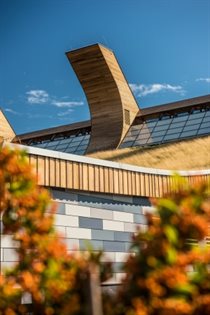The University of Nottingham has seen internal space across campuses increase by almost half in the last fifteen years. Nevertheless, this is matched by a disproportionately smaller increase in overall energy use of 6% in the same period, reflecting the adoption of energy efficient design and efforts towards energy reduction.
The University’s renewable energy capacity has also increased since 2002/3 almost twentyfold with a current capacity of 1,148kW, with solar panels at the GlaxoSmithKline Carbon Neutral Lab at Jubilee and Vet School at Sutton Bonington having the largest capacity.
Despite floor area increasing by 48%, overall energy consumption has seen only a moderate increase of 6%. The extensive developments of Jubilee campus, the acquisition of King’s Meadow Campus, and the growth of buildings on University Park and Sutton Bonington have resulted in the expansion of indoor space, reflecting trends of expanding estates across the higher education sector.
Electricity use has risen, with a considerable rise between 2002/3 and 2009/10 of 27%, but only increasing 2% from 2009/10 to the present day. This is countered by decreases in gas consumption of 6% over the last 15 years, due to savings at the Medical School and University Park.
Water consumption has also decreased by 2% since 2002/3, but variable use reflects a potential to improve performance further, particularly with a view to reducing leaks across the estate.
See the summary report on trends in energy and water consumption from 2002/3.
Posted on Tuesday 31st October 2017